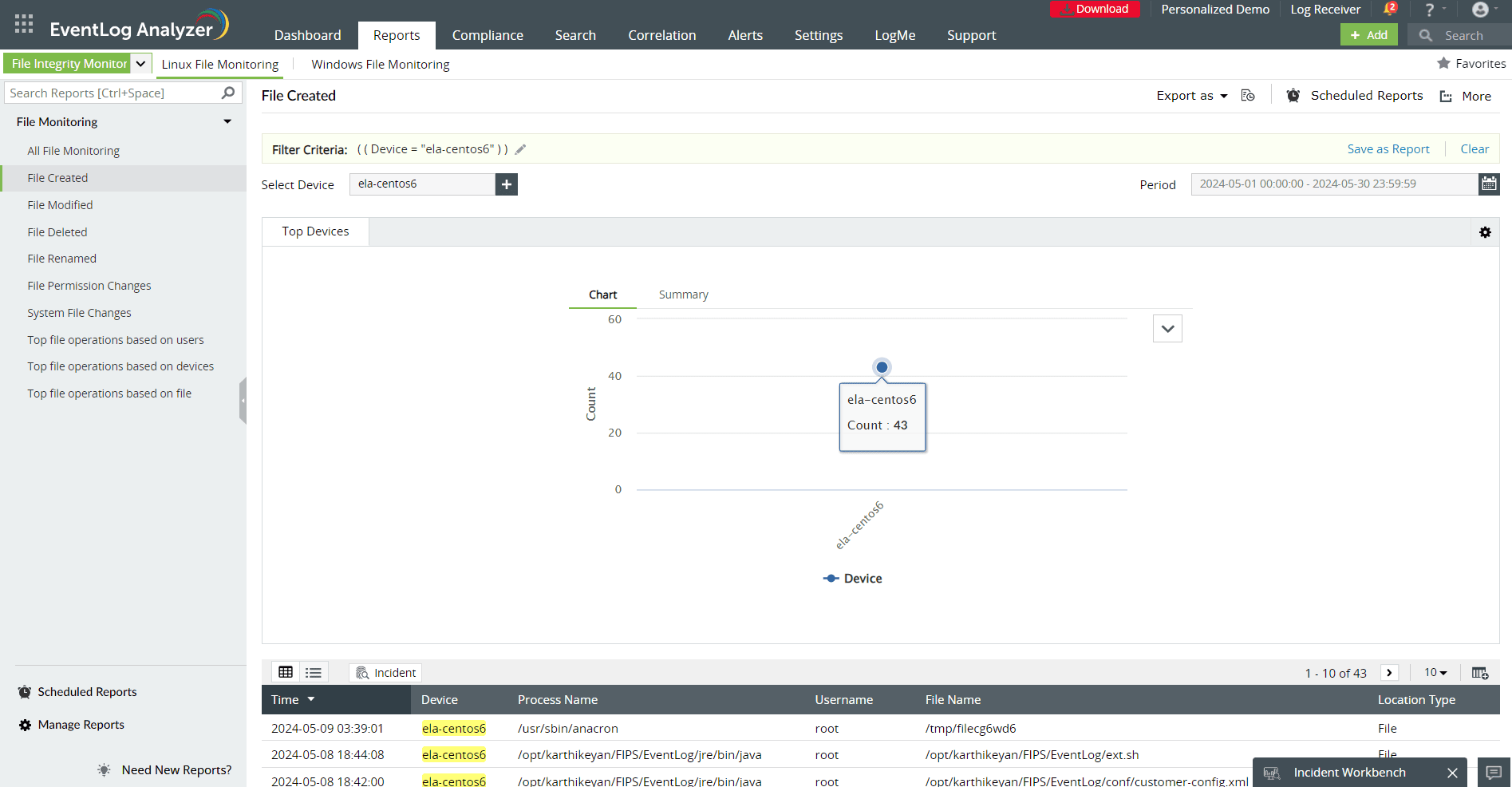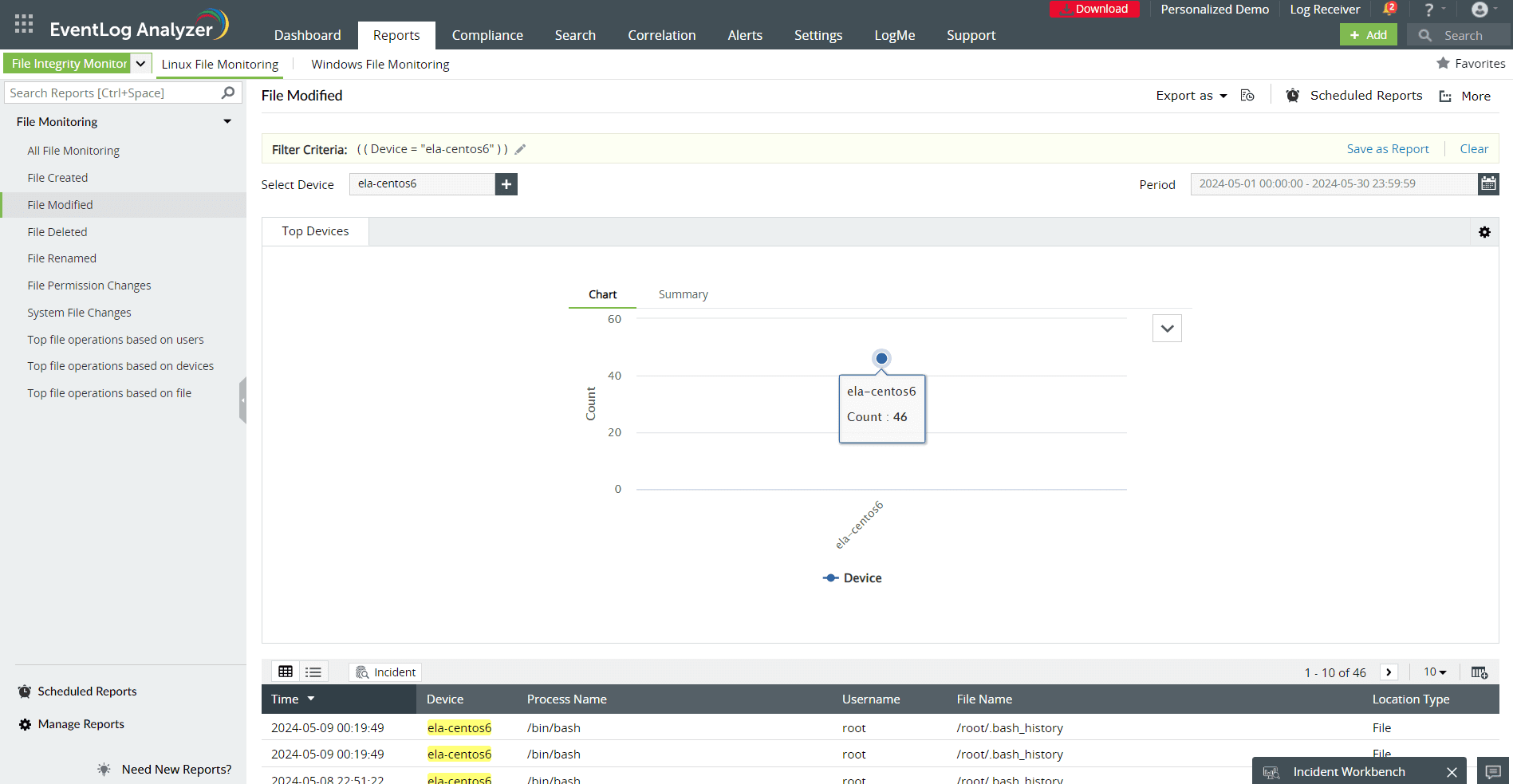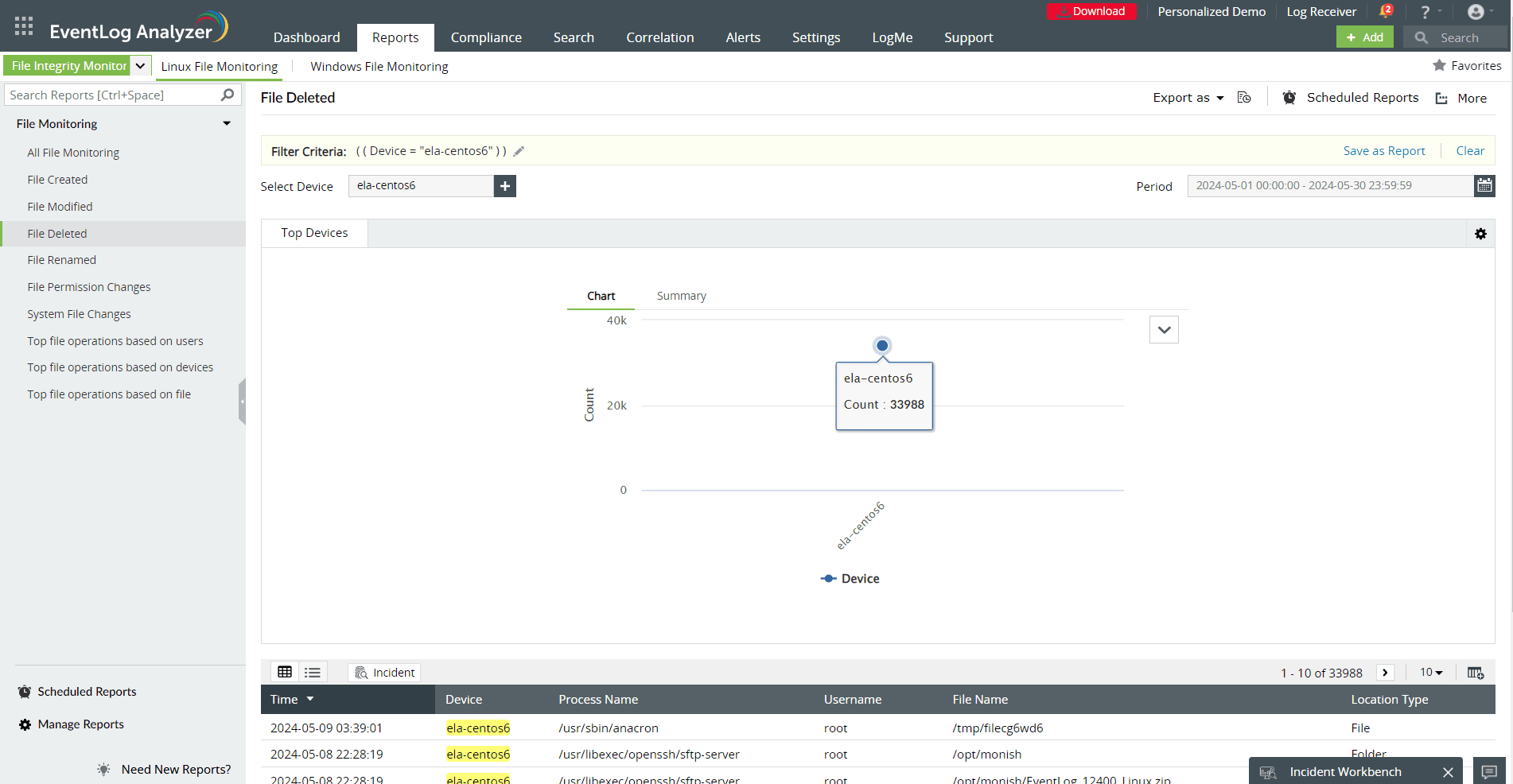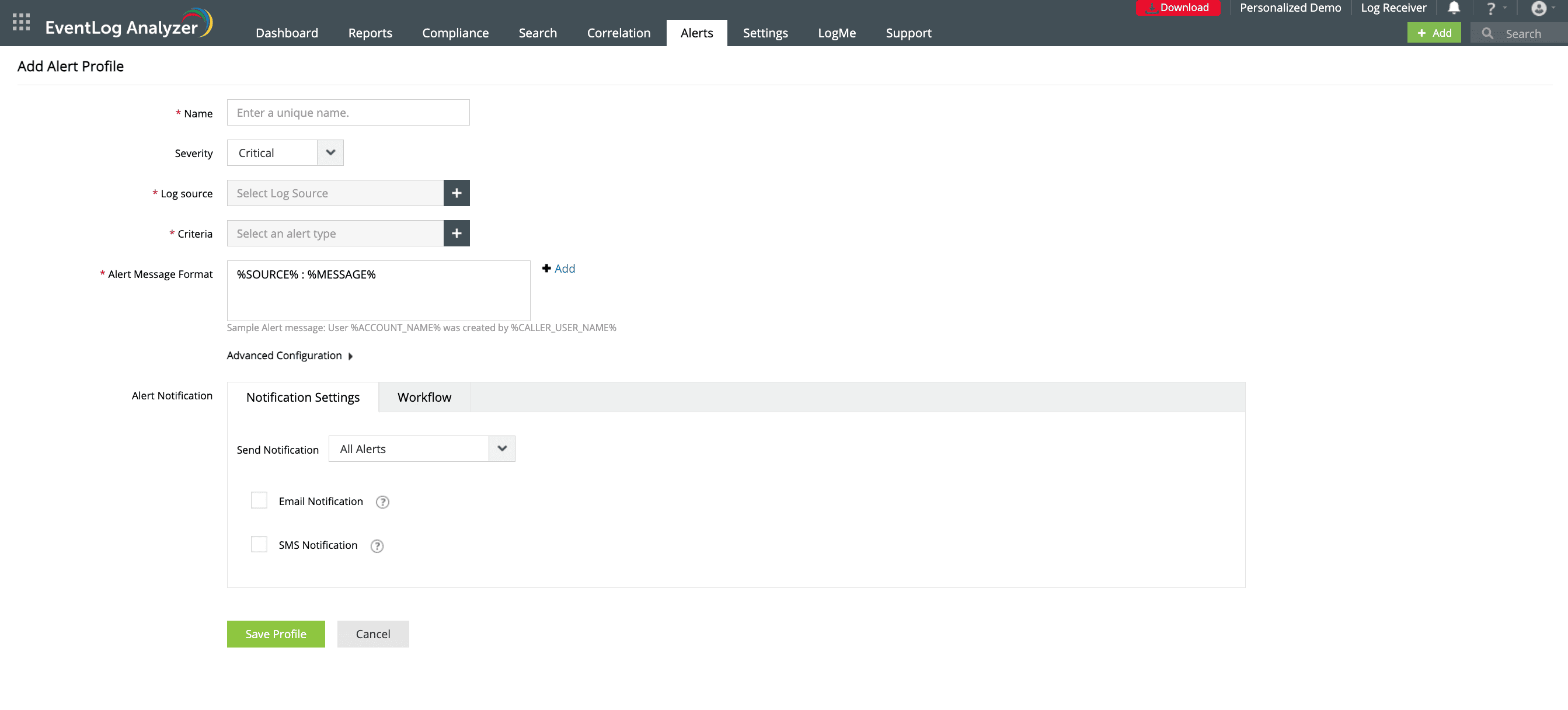- Home
- Logging Guide
- What is the find command in Linux?
What is the find command in Linux?
In this page
- What is the find command in Linux?
- What is the basic syntax of the find command in Linux?
- What are the most common options used with the find command in Linux?
- How to combine multiple search criteria in the find command in Linux?
- Leveraging EventLog Analyzer for Linux file monitoring
The find command is one of the most powerful and versatile tools available in Linux for searching files and directories. It allows users to locate files and directories based on various criteria, including name, size, type, and modification time. This command is indispensable for system administrators, developers, and cybersecurity professionals who need to manage and secure their Linux systems effectively.
Understanding the find command is crucial for several scenarios, such as:
- Locating misplaced files: Quickly find files that may have been moved or misplaced.
- Identifying large files: Discover large files that may be consuming valuable disk space.
- Auditing system changes: Track changes to files and directories for security audits and compliance.
Basic syntax of the find command in Linux
The basic syntax of the find command in Linux is structured as follows:
find [path] [options] [expression]
Components of the syntax include:
- path: This specifies the starting directory for the search.
- For example, find/path/to/search indicates where the search will begin
- options: These are additional settings or conditions that modify the behavior of the search.
- For example, you can use -type f to search for files or -type d to search for directories.
- expression: This defines the criteria for filtering and locating files.
- For instance, -name ".txt" will search for files with a .txt extension.
Here are a few examples demonstrating the syntax:
- Find all .txt files in a directory: find /path/to/search -name ".txt"
- Find directories only: find /path/to/search -type d
- Find files larger than 1 MB: find /path/to/search -size +1M
This command structure allows for extensive customization of file searches in Linux, making it a powerful tool for managing files and directories efficiently.
What are the most common options used with the find command in Linux?
Here are some of the most commonly used options with the find command in Linux:
Finding files by name:
| Command | Description | Syntax | Output |
|---|---|---|---|
| -name | Search for files with an exact name match | find /path -name "filename" | Lists files with the exact name |
| -iname | Case-insensitive search for files by name | find /path -iname "filename" | Lists files with case-insensitive matching |
| -path | Search by relative path and filename | find /path -path "*directory/filename" | Lists files matching the path |
Finding files by type:
| Command | Description | Syntax | Output |
|---|---|---|---|
| -type f | Search for regular files | find /path - type f | Lists regular files |
| -type d | Search for directories | find /path - type f | Lists directories |
| -type l | Search for symbolic links | find /path - type f | Lists symbolic links |
Finding files by size:
| Command | Description | Syntax | Output |
|---|---|---|---|
| -size +100M | Find files larger than 100 MB | find /path -size +100M | Lists files larger than 100 MB |
| -size -1k | Find files smaller than 1 kB | find /path -size -1k | Lists files smaller than 1 kB |
Finding files by time:
| Command | Description | Syntax | Output |
|---|---|---|---|
| -mtime -7 | Find files modified within the last seven days | find /path -mtime -7 | Lists files modified within the last seven days |
| -atime +30 | Find files accessed more than 30 days ago | find /path -atime +30 | Lists files accessed more than 30 days ago |
| -ctime 1 | Find files with status changed exactly one day ago | find /path -ctime 1 | Lists files with status changed one day ago |
Finding files by user/group:
| Command | Description | Syntax | Output |
|---|---|---|---|
| -user | Find files owned by a specific user | find /path -user username | Lists files owned by the specified user |
| -group | Find files owned by a specific group | find /path -group groupname | Lists files owned by the specified group |
Combining criteria:
| Command | Description | Syntax | Output |
|---|---|---|---|
| -and | Combine multiple search criteria (logical AND) | find /path -name "filename" -and -size +100M | Lists files matching both criteria |
| -or | Combine multiple search criteria (logical OR) | find /path -name "filename" -or -size +100M | Lists files matching either criteria |
| -not | Negate a search condition | find /path -not -name "filename" | Lists files that do not match the name |
Executing commands on found files:
| Command | Description | Syntax | Output |
|---|---|---|---|
| -exec | Execute a command on each found file | find /path -name "filename" -exec command {} \; | Executes the specified command on each found file |
The find command helps you locate files based on a wide range of criteria. Combining options allows you to narrow down your search to find exactly what you need.
How to combine multiple search criteria in the find command in Linux?
Linux find command is flexible and allows you to combine multiple search criteria using logical operators for effective functioning.
- Combining Criteria with -and: To find files that match multiple criteria, you can use -and to combine them.
- For example, to find files larger than 1 MB modified in the last seven days: find /path/to/search -size +1M -and -mtime -7
- This searches for files larger than one megabyte (-size +1M) that were modified within the last seven days (-mtime -7).
- Using -or to find files matching any criteria: To find files matching any of the specified criteria, use -or.
- For instance, to find files with .txt or .pdf extensions: find /path/to/search \( -name ".txt" -or -name ".pdf" \)
- The parentheses group the criteria together to apply the -or logic.
- Negating Criteria with -not: To exclude files matching certain criteria, use -not.
- For example, to find all files except .txt files: find /path/to/search -not -name ".txt"
- This will return all files in the directory that do not have a .txt extension.
- Combining multiple criteria: You can combine multiple criteria using a combination of -and, -or, and -not.
- For example, to find .txt or .pdf files larger than 1 MB, excluding files owned by user1: find /path/to/search \( -name ".txt" -or -name ".pdf" \) -and -size +1M -and -not -user user1
- This command searches for .txt or .pdf files (-name ".txt" -or -name ".pdf") larger than 1 MB (-size +1M) that are not owned by user1 (-not -user user1).
Remember to enclose criteria with parentheses when using -or and -not to ensure proper logical grouping. The find command allows for flexible and powerful searches by combining multiple conditions.
How to leverage ManageEngine EventLog Analyzer for Linux file monitoring?
ManageEngine EventLog Analyzer is a comprehensive log management and IT compliance tool that helps you to detect security threats, conduct compliance audits, and ensure data security. This Linux monitoring tool comes with file integrity monitoring (FIM) capability to track changes to Linux file and folders.
Here's how EventLog Analyzer helps you monitor your Linux file and folder:
- File creations: Track when and by whom a new file is created to prevent unauthorized or malicious files from being introduced into your environment.
- File modifications: Track changes made to files, such as edits or updates, ensuring that any unauthorized modification attempts are flagged immediately.
- File deletions: Audit file deletions to ensure that critical data is not removed without proper authorization. This helps in protecting sensitive information and identifying potential data breaches.
- File renaming: Monitor file renaming activities to detect attempts to hide or tamper with sensitive data.
- Predefined alerts to detect unauthorized access: Get notified on unauthorized access to critical Linux files including access in real-time, during non-business hours with predefined alert profiles.
- Intuitive reporting: The audit trail for all file activities is presented through intuitive reports that provide a granular view of file operations. These reports are designed to meet regulatory compliance requirements (such as GDPR, HIPAA, or SOX), helping you ensure that your file activity logs are both detailed and easily accessible during audits.
















